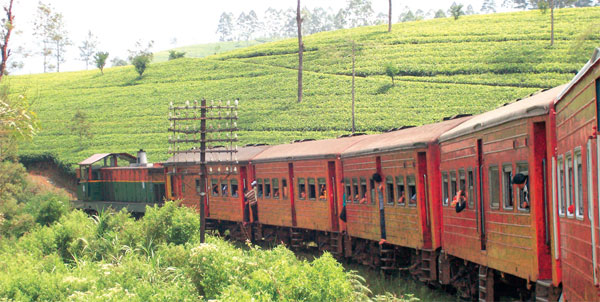|
Great Railway:
Journeys of the World
We carry below a follow-up story to the Badulla railway sent to us by
a reader, Nithuli Subasinghe which appeared on September 22.
The main railway line from Colombo to Badulla, 300 km or 180 miles in
length, ranks as one of the "Great Railway Journeys of the World". It
offers breathtaking and spectacular views that are considered to be
unparalleled beauty of Sri Lanka. The amazing diversity of landscapes,
climate, geographical elevations, and mist clad mountains, valleys and
waterfalls are found along the route. The magnificent railway via ducts,
bridges and tunnels are examples for impressive engineering feats.
The history of the rail track of Sri Lanka dates back to August 3,
1858 when the British governor, Sir Henry Ward cut the first sod to
construct the railway line to Kandy. The track was laid by the colonial
rulers, in response to repeated requests made by the European planters
to transport their produce for export to the UK as shipment had to be
done in Colombo. It then took almost 12 days for a bullock cart to make
the marathon journey, 72 miles from Colombo to Kandy.

The first 74 mile section was the first line built in Sri Lanka. It
was opened to Ambepussa in 1864 and then to Kandy in 1867. The line
extended in stages with a short spur from Peradeniya junction into Kandy
to Nawalapitiya in 1874, to Nanu-Oya in 1885, to Bandarawela in 1894,
and to Badulla in 1924.
The train journey from Colombo to Kandy starts at a 14 feet elevation
in Colombo and runs up to Rambukkana, some 85 km away through almost
flat country with the views of rice cultivation in various stages,
coconut palms and charming villages of the countryside. The train then
begins to ascend Kadugannawa incline, the climb of 1,400 ft in 13 miles
which is considered as a major engineering marvel.
The railway line from Balana and Kadugannawa railway stations is
fitted to an 18 ft ledge of rock on one side.
As the train takes the bend under the 'Lions Mouth' (overhanging rock
resemblance to the face of a lion), an exciting view of a steep drop
into the valley is found.
The maximum speed on this stretch is 32 km/ph. The Balana Pass
through which the train ascends to Kadugannawa was a strategic military
point during the period of ancient kings, to keep watch over the enemies
who tried to infiltrate in to the kingdom of Kandy.
Throughout the climb the views are magnificent, including the
flat-topped Bible Rock and Utuwankanda Castle Rock where Saradiel, the
Robin Hood of Ceylon, had his hideout to screen the movements of
carriages over the low lands.
From Kadugannawa at (1,700 ft) , the line drops gently to Peradeniya
at 1,553 ft crossing the Mahaweli, Sri Lanka's longest river and then
rises again to a height of 1,602 ft at Kandy.
The Colombo - Kandy railway is a masterpiece of railway engineering
which took nine years to complete. The sensational information behind
this achievement was that many lives were lost during the construction.
The death toll through malaria was heavy and labour was hard to find.
There were unforeseen delays due to monsoon rains, floods and
landslides.
The train journey continues to climb from the Peradeiniya Junction
through the scenic tea country, connecting main local market centres at
Gampola, Nawalapitiya and Hatton before reaching Nanu-Oya at a height of
5291 ft.
The real Ghat Section begins beyond Nawalapitiya and the train climbs
to the mountains with a steep gradient and tight curves for 53 miles
passing through a number of bridges, culverts and many tunnels.
The extension is one of the finest stretches of scenery including the
St Clair Falls, Devon Falls, the magnificent mountain range of Great
Western and the spectacular mountain valley of Nuwara Eliya. The famous
Adams Peak (Sri Pada) can also be seen in between.
Among the tunnels on this stretch is the longest Pool bank tunnel
between Hatton and Kotagala, which is 1,842 ft. long, with a curvature
in the middle so that from one end the other end is not seen.
The train, after making a big loop, eventually reaches Nanu-Oya, the
station for Nuwara Eliya at 6,199 ft, the highest city in Sri Lanka
renowned for its cool and healthy climate.
The train continues its ascent from Nanu-Oya passing through the
forest flanked by Conical Hill and later greater mountains of Hakkagala
on to the 'Summit' level of 6226 ft above sea level, 3/4 mile beyond the
Pattipola Station.
This is considered to be a major engineering feat and the highest
point reached by a 5' 6" broad gauge railway line in the world.
More of this magical train journey next week. |

